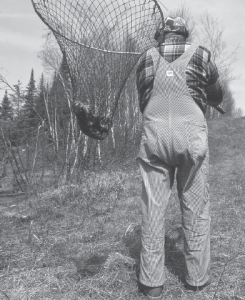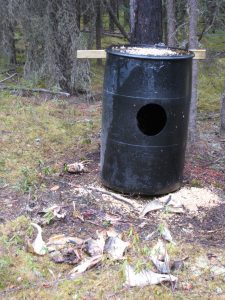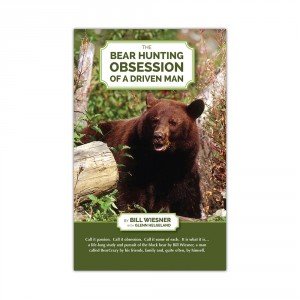Odorous, in the extreme, and not a good idea
by Bill Wiesner (he’s taken 57 bears; he knows bears)
After a wild beginning (shooting a bear on my first day of my first season of Wisconsin deer hunting), the next several years found me at deer camp looking for another bear encounter. It was not to be, but I remained a hopeful kid.
Turn the clock ahead to 1966 -1969, my high school years. My teachers may not have believed it, but I learned a lot those years – mostly about deer hunting and black bears. I could hunt the north woods and use the high school library to learn more about the black bear.
In late 1969 I joined the Marine Corps, another family tradition. I saved as much money as I could because I had a plan in place well before my discharge in 1971.
My first purchase when I returned home was a brand new 1972 Ford F-150, all black, with a four-speed on the floor and a six-cylinder engine. I took it to my buddy’s tire shop and put on custom rims and big tires. That poor six-cylinder had to work to turn those big tires, but I had the coolest looking bear hunting rig on the road.
Because there were no bears where I lived, I traveled to Beecher in northeastern Wisconsin to bait. My job at a manufacturing plant in Sturgeon Bay started at 7:00 am. I would drive two-and-a-half hours to my intended hunting area, bait the stands and drive back to Sturgeon Bay to clock in at work on time. Figuring five hours round trip on the road, and a couple of hours baiting, this meant getting out of bed at midnight.
The first three weeks of baiting, I made the trip three times a week. After that, it was every other day.
One Friday morning on my trip home I stopped at a roadside restaurant for a fast breakfast. An elderly gentleman, dressed in his outdoor attire, sipping on a cup of coffee, was the only other customer. I struck up a conversation and discovered he was a trapper.
My questions were many. I explained I was a bear hunter, trying to discover locations of bear in the area so I could bait and then hunt closer to home.

One of the biggest fallacies in bear hunting is that bears like odorous bait and dead fish make the most odor. So, therefore, catch a bunch of suckers and let them decompose. Wrong, wrong, wrong. I tried this bait route once. Never again. Black bears like fresh bait and they have a sweet tooth.
It seemed my existing baits were in good locations, but he asked what I used for bait. After explaining my ‘secret’ formula to him, he said he could give me the ultimate attractant. He asked if I could get my hands on some rough fish.
“I sure can,” I said. “I live on Lake Michigan. It’s too late this year, but in the spring suckers are plentiful.”
“Here’s what you do,” he said. “Take a five-gallon pail of suckers cut in chunks and set them out in the sun for the summer until you start baiting.”
That’s what I did.
During the summer, as the suckers decomposed, the odor that came from the pail was horrible. A wind off Lake Michigan gave us all a sample of the world’s greatest bear attractant. I knew that it was offensive by the number, or lack of, visitors we had that summer. We couldn’t escape that pail’s aroma no matter where we set it, that’s how powerful the stench was.
When the baiting season came around, the contents of that pail had turned to liquid!
It was hard driving to the bait sites and back home with my secret scent in the bed of the truck. One morning I was traveling smooth, listening to tunes on the radio, sipping on a cup of coffee when a car pulled out from a side road right in front of me. I hit the brakes.
The sound I heard next was the five-gallon pail of my wonderful new attractant hitting the front of the truck box. In an instant that stench sent me bailing out of the truck. I emptied my stomach right there on the side of the road.
The trip home seemed like it would never end. The nice rubber mat I had in the back was headed to the dump. I tried everything but could not get the stink out of it. It was so bad, I doubt whether a dog would roll in it.
As the years passed, I often wondered if that old trapper had a good laugh over my greenhorn actions creating and handling what he said was the world’s greatest bear attractant.
– – – – – – – – –

Fish are not particularly good as an attractant; bears ignored these fish scraps so long the scraps dried up. The eight-inch hole in the barrel is a sizing tool for bear. If a bear cannot get its head in the hole, it’s a shooter.
My ‘secret’ scent mixture …
For an effective attractant scent, I boil sweet-smelling thimbleberries — they grow in northern Wisconsin and bears love them — with artificial honey and anise (available in the cooking supplies section of any grocery store) in a kettle on the stove. I turn the heat to low and stir often. When the mixture is a thick liquid it is ready.
I smear the mixture on trees around the bait. I never used drip cans or scent wicks in pre-season baiting. Once the season opens, drip cans and scent wicks make sense because that will allow me to take them into and out of the bait scene as I want or need to.
The scent mixture and pre-season use have worked well. I use it to this day.
I pick wild thimbleberries because I like them and bears like them. Other berries should work, especially those grown wild or domestically in bear country.
THE BEAR HUNTING OBSESSION OF A DRIVEN MAN is 162 pages, 5.5″ x 8.5″, paperback. It is available at www.targetcommbooks.com. Cost is $14.95, plus $4.00 shipping/handling.
BILL WIESNER — Author of The Bear Hunting Obsession of a Driven Man
Bill Wiesner, a man often called “BearCrazy” by friends and family, has had a lifelong passion for studying and hunting black bears. He has taken 57 black bears. He, his wife and two sons have taken more than 100, 30 of which qualify for the Pope & Young record book and seven of which qualify for the Boone & Crockett record book.
Bill and his family have hunted black bear in Wisconsin, Michigan, Minnesota, Wyoming, Quebec, Saskatchewan, Manitoba and Ontario.
They have taken bears over baits, by spot and stalk, and behind hounds. They have taken them with self-bow (homemade, with stone arrowheads), recurve bow, longbow, compound bow, crossbow, muzzleloader, rifle and shotgun with slugs.
His book has 10 hunting how-to chapters and 10 memoir chapters.
How-to chapters include black bear natural history; distribution, population & record book entry totals (by state and province); hunting gear (rifle, slug gun, handgun, muzzleloader, bow, crossbow), camo, and other necessary bear hunting items; hunting from ground blinds; hunting styles (D-I-Y, guided, hounds, spot-and-stalk); scouting; baiting and scents; new twists (food plots, calling, decoying); the shot (before, during, after); care of hide for taxidermy; care of meat (processing, freezing, recipes).
Memoir chapters — all entertaining reading — include strange or unusual incidents, personalities and bears encountered, plus family involvement during the author’s years of growth as a bear hunter.
Bill was the first hunter to complete the Great Lakes Grand Slam (deer, bear, turkey) with all types of bowhunting equipment – compound bow, recurve bow, longbow, and selfbow with stone heads. This means he has taken all three species with each type of bow.
He was the first hunter to receive all five (coyote, bobcat, turkey, deer, bear) Wisconsin Bowhunters Association pin awards for animals taken in one season. This is extremely difficult, due principally to Wisconsin’s point system for issuing bear tags.


